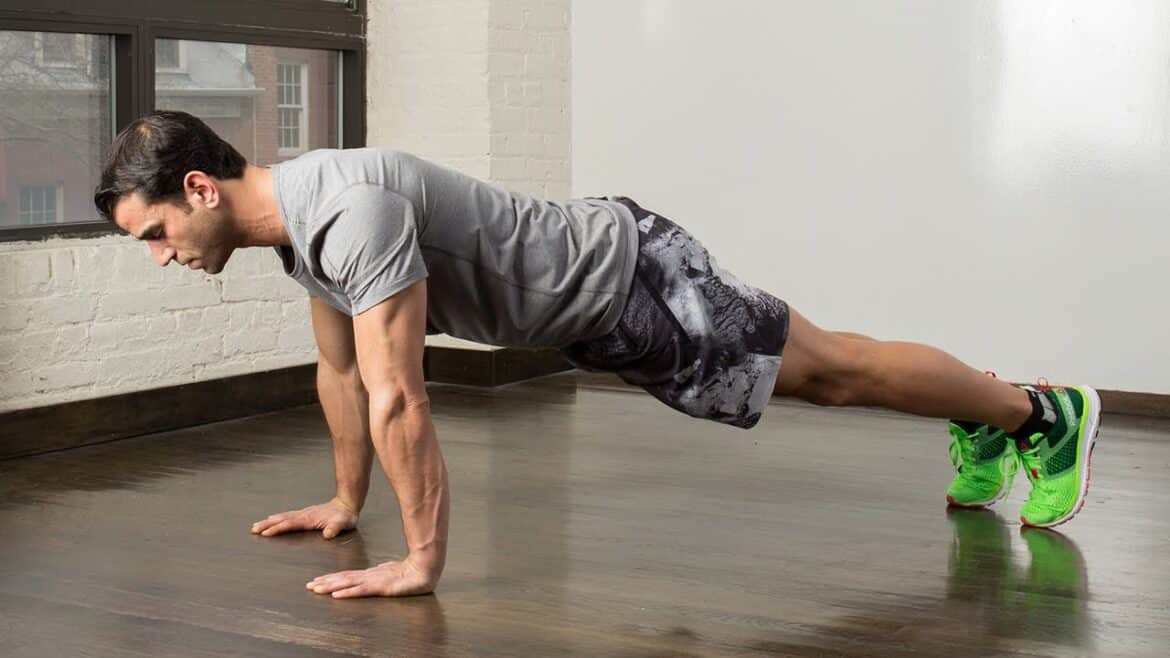Introduction
How Many Calories Does 100 Pushups Burn: Push-ups are a bodyweight exercise that engages multiple muscle groups simultaneously, including the chest, shoulders, triceps, and core. As you perform each rep, your body works hard to lift its weight against gravity, which expends energy in the form of calories. To quantify the exact number of calories burned during 100 push-ups, it’s essential to consider various factors, such as your body weight, the intensity of your push-ups, and the duration of your workout.
The science behind push-ups and provide you with a comprehensive understanding of the calories you can expect to burn when incorporating this exercise into your fitness regimen. Push-ups are not just a strength-building exercise; they also elevate your heart rate, making them an effective addition to a cardio workout routine.
The calorie burn during push-ups is influenced by your body weight, as individuals with more mass will generally burn more calories. The intensity of your push-ups, including variations like incline or decline push-ups, impacts the energy expenditure. Whether you’re looking to lose weight, maintain your current physique, or simply enhance your overall fitness, knowing how many calories you can burn through 100 push-ups can help you tailor your workouts to meet your specific goals.

How many calories burned in 100 push ups?
How many calories does a push up burn? When you do 100 push ups, you are going to find that this burns around 30 to 50 calories. While this doesn’t seem like a lot, you are going to find that the benefits of push ups is what makes this an exercise that you should do in your daily workout.
The number of calories burned during 100 push-ups can vary based on several factors, including your body weight, the intensity of the push-ups, and your overall fitness level. On average, a person who weighs around 155-160 pounds (70-73 kg) can burn approximately 34-40 calories by performing 100 standard push-ups in a single set. This is a rough estimate and can vary significantly depending on individual factors.
For a more accurate calculation, you can use a fitness tracker or online calculator that takes into account your specific weight and the intensity of your push-ups. Keep in mind that doing different types of push-ups (e.g., incline, decline, diamond push-ups) may also affect the calorie burn, as they engage different muscle groups and vary in intensity.
It’s essential to remember that while push-ups can be a great addition to your fitness routine, they are just one part of the overall equation for managing your calorie expenditure and achieving your fitness goals. To burn more calories and see the best results, it’s important to have a well-rounded fitness program that includes a mix of cardiovascular exercises, strength training, and a balanced diet.
Is 100 pushups a day a good workout?
100 push-ups a day isn’t too much, especially when you break it up into sets. However, if you can’t do 100 push-ups a day yet, training will help you get stronger. But if you’re already able to do 100 push-ups, even completing them in a few sets, it won’t bring much benefit.
Strength and Endurance: Doing 100 push-ups in a day will undoubtedly improve your upper body strength and endurance over time. It can help build and tone your chest, shoulders, triceps, and core muscles.
Consistency: Consistency is key in any fitness routine. If you’re consistent with your daily 100 push-ups, you’ll likely see improvements in your upper body strength and muscle endurance.
Variation: To maximize the benefits and avoid plateaus, it’s a good idea to include variations of push-ups (e.g., wide grip, close grip, decline, incline) in your routine. This will target different muscle groups and prevent overuse injuries.
Balance: While push-ups are great for your upper body, a well-rounded fitness program should include cardiovascular exercise, lower body strength training, flexibility, and a balanced diet for overall health and fitness.
Recovery: Ensure you allow your muscles to recover. Overtraining can lead to injuries and burnout. It’s important to listen to your body and provide it with the rest it needs.
Progression: As you get stronger, consider increasing the number of push-ups, changing the variations, or adding other exercises to your routine to continue challenging yourself.
Goals: Your goals matter. If you’re aiming for general fitness and toning, 100 push-ups a day can be a valuable addition. However, if your goals involve specific strength gains or muscle building, you may need to incorporate a more varied and structured strength training program.
Is 500 pushups a day good?
At 500/500/100+ reps a day, you should only do that every other day max. In fact, I would only get that kind of volume once a week, as you really are taxing your muscles/muscle endurance with this many reps.
Overtraining and Injury Risk: Performing such a high volume of push-ups on a daily basis greatly increases the risk of overtraining, which can lead to injuries, muscle imbalances, and burnout. Pushing your body to this extreme can strain your shoulders, wrists, and elbows.
Lack of Balance: Focusing solely on one exercise, even one as effective as push-ups, can lead to muscle imbalances. Neglecting other muscle groups and aspects of fitness, such as cardiovascular conditioning and flexibility, can be detrimental to your overall health and fitness.
Diminishing Returns: After a certain point, doing an excessive number of push-ups may not lead to significantly more gains in strength or endurance. You may reach a point of diminishing returns where the time and effort you invest don’t provide much additional benefit.
Time and Sustainability: Performing 500 push-ups a day is extremely time-consuming. Maintaining this routine may become unsustainable for most people due to time constraints and other commitments.
What is the maximum push-ups per day?
There is no limit to how many push-ups one can do in a day. Many people do more than 300 push-ups a day. But for an average person, even 50 to 100 push-ups should be enough to maintain a good upper body, provided it is done properly. You can start with 20 push-ups, but do not stick to this number.
The maximum number of push-ups a person can do in a day varies widely depending on their individual fitness level, training, and physical condition. There is no one-size-fits-all answer to determine the absolute maximum number of push-ups a person can perform in a day.
For elite athletes and highly trained individuals, it’s not uncommon to see numbers in the hundreds, or even well over a thousand push-ups in a single day. These individuals have developed exceptional strength and endurance, and their bodies are conditioned to handle such high volumes of exercise.
However, it’s important to note that extremely high numbers of push-ups, like hundreds or thousands in a single day, are usually achieved by those with specialized training and are often part of specific challenges, competitions, or training regimens. It’s not advisable for the average person to attempt such high numbers of push-ups without proper training and conditioning.
For most people, it’s recommended to start with a more reasonable and sustainable daily push-up goal, such as 50 to 100 push-ups, and gradually increase the number as your strength and endurance improve. Always prioritize good form and listen to your body, ensuring that you don’t push yourself to the point of overtraining or injury. It’s essential to balance your fitness routine with other types of exercises and activities for overall health and fitness.
Can pushups reduce chest fat?
The short answer is “no,” but that doesn’t mean that push-ups can’t contribute toward acquiring a flatter, firmer chest. Understanding more about how your body sheds fat and builds muscle could help you formulate a plan for a leaner upper-body profile.
Diet: You need to maintain a calorie deficit to lose body fat. This means you should consume fewer calories than you burn. Focus on a balanced and healthy diet with a mix of macronutrients (protein, carbohydrates, and fats) and micronutrients (vitamins and minerals) to support your overall health and energy levels.
Cardiovascular Exercise: Incorporating cardiovascular exercises like running, cycling, swimming, or brisk walking into your routine can help increase your overall calorie expenditure and promote fat loss throughout the body.
Strength Training: Strength-training exercises like push-ups can help build muscle, which can boost your metabolism and improve the appearance of the chest area. While it won’t directly target chest fat, it can contribute to a more toned and defined chest.
Consistency: Consistency in both exercise and diet is crucial for sustainable fat loss. It takes time to see significant changes in body composition.
Full-Body Approach: Instead of focusing solely on push-ups, incorporate a full-body exercise routine that includes a variety of exercises to target different muscle groups. This can help with overall fat loss and muscle development.
Patience: It’s important to note that spot reduction (targeting fat loss in a specific area) is not supported by scientific evidence. Your body will lose fat from different areas at its own pace, influenced by your genetics and individual factors.
What exercises burn belly fat?
Aerobic exercise includes any activity that raises your heart rate such as walking, dancing, running or swimming. This can also include doing housework, gardening and playing with your children. Other types of exercise such as strength training, Pilates and yoga can also help you lose belly fat.
Cardiovascular Exercise: Aerobic exercises that raise your heart rate and increase calorie expenditure are effective for overall fat loss. These include activities like running, brisk walking, cycling, swimming, and dancing. Aim for at least 150 minutes of moderate-intensity cardio exercise per week.
High-Intensity Interval Training (HIIT): HIIT involves short bursts of high-intensity exercise followed by brief periods of rest. It’s an efficient way to burn calories and improve fat loss. HIIT can be done with exercises like sprints, jumping jacks, or burpees.
Strength Training: Building lean muscle mass through strength training can boost your metabolism and help you burn more calories, even at rest. Exercises like squats, deadlifts, bench presses, and planks are effective for building muscle.
Core Exercises: While not spot-reducing belly fat, core exercises like planks, Russian twists, and leg raises can strengthen the abdominal muscles and improve the appearance of the midsection.
Full-Body Workouts: Engaging multiple muscle groups through compound exercises can be highly effective for fat loss. Examples include kettlebell swings, rowing, and total-body circuit workouts.
Diet and Nutrition: A healthy, balanced diet is crucial for reducing overall body fat, including belly fat. Focus on whole, unprocessed foods, and maintain a calorie deficit (consume fewer calories than you burn) to lose weight. Reducing refined carbohydrates and added sugars can be particularly beneficial.
Hydration: Staying well-hydrated supports metabolic processes and can help control appetite.
Adequate Sleep: Lack of sleep can interfere with hormonal regulation and increase cravings for unhealthy foods. Aim for 7-9 hours of quality sleep per night.
Stress Management: Chronic stress can lead to increased abdominal fat. Practices like meditation, yoga, and deep breathing exercises can help manage stress.
Consistency: Long-term, sustainable changes are key to success. Be consistent with your exercise routine and dietary choices.
How can I burn 500 calories a day?
Walking at speed of 4 MPH for 90 minutes will help you burn 500 calories. At work too, you should walk after lunch but it should not be a brisk walk. This will help you digest food and you will not gain extra weight. Brisk walking for 10 minutes will help you lose 81 calories.
Running: Running at a moderate pace can burn around 500 calories per hour. The exact number of calories burned depends on factors like your weight and running speed.
Cycling: Riding a bike, whether indoors on a stationary bike or outdoors, can help you burn around 500 calories per hour.
Swimming: Swimming is a full-body workout that can burn a substantial number of calories. An hour of swimming can burn approximately 500 calories, but this can vary depending on your swimming style and intensity.
Jumping Rope: Jumping rope is an excellent cardiovascular exercise that can help you burn calories quickly. Jumping rope for 30-45 minutes can burn around 500 calories.
High-Intensity Interval Training (HIIT): HIIT workouts involve short bursts of high-intensity exercise followed by brief rest periods. A 30-40 minute HIIT session can burn approximately 500 calories.
Aerobic Dance or Zumba: Participating in aerobic dance or Zumba classes for about an hour can also help you reach your calorie-burning goal.
Elliptical Trainer: Using an elliptical machine at a moderate intensity can help you burn around 500 calories per hour.
Strength Training: While not as calorie-intensive as cardiovascular exercises, strength training can help you build lean muscle, which in turn boosts your metabolism. A solid strength training session with compound exercises can contribute to calorie burning.
Walking: Walking briskly for an extended period, such as 60-90 minutes, can burn roughly 500 calories, depending on your walking speed and body weight.
Hiking: Going on a challenging hike in nature can provide an opportunity to burn calories while enjoying the outdoors. The exact number of calories burned will depend on factors like terrain and intensity.
Is 200 push-ups a day a lot?
Whichever approach followed, both would lead to increased strength and better push-ups ability, and maybe even some lost body fat along the way too. However, 200 push-ups every single day is brutal, and if anything, this challenge demonstrates how vital rest is in any fitness routine.
Fitness Level: For some individuals, 200 push-ups in a day may be an achievable goal, especially if they have developed the strength and endurance to perform high-repetition push-ups. However, for others, it may be a significant challenge.
Goals: Consider your fitness goals. If your primary goal is to improve upper body strength, muscle endurance, or to master a specific push-up variation, 200 push-ups may be appropriate. If your goal is more focused on overall fitness or weight loss, you should include a variety of exercises and cardio workouts in your routine.
Quality over Quantity: Performing push-ups with proper form is more important than the sheer number of repetitions. Make sure you maintain good form to avoid potential injury and maximize the benefits.
Variation: Incorporating different types of push-ups (e.g., wide-grip, close-grip, incline, decline, diamond push-ups) can help target various muscle groups and add diversity to your workout.
Rest and Recovery: It’s crucial to allow your muscles time to recover. Performing 200 push-ups every day without adequate rest can lead to overuse injuries. Consider incorporating rest days and allowing specific muscle groups to recover.
Balance: A well-rounded fitness routine includes cardiovascular exercise, strength training for other muscle groups, flexibility work, and a balanced diet. 200 push-ups should be part of your overall plan, not the sole focus.
Progression: If you’re starting from a lower number of push-ups, gradually increase the number over time to avoid overexertion. Progression is key to safely and effectively improving your performance.

Conclusion
The calorie-burning potential of 100 push-ups, we have unraveled the multifaceted nature of this classic exercise. Push-ups offer a dynamic workout that not only strengthens and tones the upper body but also provides a cardio and calorie-burning component to your fitness regimen. While the precise number of calories burned during 100 push-ups varies based on individual factors, such as body weight and the intensity of the exercise, understanding the science behind push-ups and their contribution to your overall calorie expenditure is a valuable insight for anyone striving for better fitness.
Moreover, our journey has underscored the importance of a holistic approach to health and wellness. While push-ups can be a powerful addition to your routine, no single exercise is a magic solution for weight management. Achieving fitness and weight goals requires a combination of exercises, balanced nutrition, and lifestyle choices that foster a sustainable, long-term commitment to well-being. Recognizing the significance of this comprehensive approach empowers us to tailor our fitness routines in a way that maximizes benefits while promoting overall health.
The pursuit of fitness is not solely about the numbers of calories burned or the quantity of push-ups completed. It’s about embracing a lifestyle that values physical well-being, appreciates the journey of self-improvement, and prioritizes the longevity and vitality that a healthy body and mind can offer. The calories burned during 100 push-ups are just one small piece of a larger puzzle, but they serve as a reminder that every step we take, every push-up we perform, contributes to our journey toward better health and fitness.

